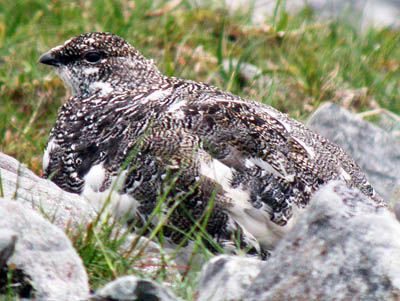 Walkers on three Scottish mountains are being asked to keep an eye out for ptarmigan.
Walkers on three Scottish mountains are being asked to keep an eye out for ptarmigan.
The bird, which changes plumage to white during winter, is rare in that it is one of the few in the British Isles which chooses the high mountains as its home. Researchers are worried that climate change could lead to its numbers declining.
A ptarmigan
Peter M Wilson
Conservation workers with the National Trust for Scotland want details of any sightings on Ben Lomond, Ben Lawers and Goatfell on Arran. The data will help the trust analyse any possible effects of changes on the high mountains owned by them.
Lindsay Mackinlay, nature conservation advisor with the National Trust for Scotland said: “Ptarmigan are one of the few birds that specialise on living on our mountain tops. The general belief is that a warming climate could make Scotland a less suitable place for them to live and breed.
“Some current predictions suggest they may only be able to survive on our highest and most northern ridges and plateaux in the future. In theory, this could mean they disappear altogether from mountains like Goatfell and Ben Lomond. However, the Trust is not satisfied that we have sufficient scientific data in the field to know what will happen to this species.
“We know that there are other factors that may well affect the ptarmigan, including grazing levels which affect its food supply and predicted increases in wind speed. Indeed, increasing wind chill may act in favour of the Ptarmigan. We just don’t know.”
Data from the three southern mountains will be compared with the trust’s more northerly Mar Lodge estate.
“We are keen to begin detailed annual surveys at Goatfell, Ben Lomond and Ben Lawers to study long-term changes in the ptarmigan populations there,” Mr Mackinlay said. “This fieldwork will hopefully feed into our management of these properties and other work out there to determine what is happening to much of our wildlife as the weather changes.”
Sightings of the bird, which is a member of the grouse family and whose colouring changes from brown in summer through to white in winter, with breeding males having grey uppers and white wings and underparts, can be reported to rangers on the estate or to Mr Mackinlay at lmackinlay@nts.org.uk.